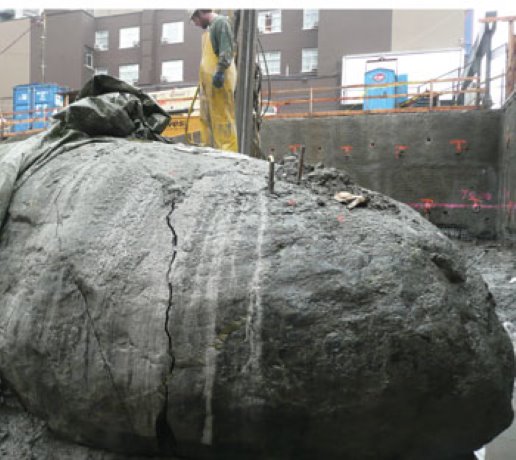It’s not every day that excavators come across something they can’t handle — like a boulder 1.5 times as big as a single-car garage.
However, an excavation was brought to a halt at a downtown Vancouver, B.C. construction site recently by a boulder just that big.
Weighing about 300 tonnes, the 20-by-17 foot boulder was scraped up from the dirt and rubble at the site of an eight-storey condo planned for Granville and Davie streets.
The mammoth rock, termed a “rogue errant,” was likely a deposit from the last ice age thousands of years ago. Rocks that huge are uncommon (a five-foot diameter boulder is more typical) at construction sites in downtown Vancouver, said Kevin Ronning, president of Southwest Contracting Ltd., the excavation and shoring contractor for the project.
That’s a good thing because removing them can be arduous.
There is no crane big enough to lift the boulder and blasting it to fragments wasn’t an option because a jarring explosion could damage an adjacent historic building and rattle windows and building structures in the high-density neighborhood.
Southwest Contracting tried several methods to break the granite mammoth. A pneumatic hammer attached to an excavator failed, as did a non-explosive gas expansion system. Boulder busting — filling shallow holes in a rock with an explosive charge — easily breaks up most boulders, but not this one.
Ronning said the rock was simply too big.
A traditional feather and wedges method, which involves drilling a series of holes, inserting steel wedges and hammering in spikes to split the rock — was equally disappointing.
Exhausting what seemed like all options, the frustrated excavator turned to Vancouver-based Ecobust Distribution International Inc. for a solution: a non-explosive liquid mixture that carries a big punch.
The harmless-looking liquid expands to four times its size and exerts up to 20,000 psi — enough pressure to break almost anything, said Ecobust president David McNamara.
The operation involved filling a series of 1.5 inch diameter holes, drilled deep into the rock with Ecobust, and then waiting for the product to do its job.
Southwest performed the task on a Friday and came back to work on Monday to find fractures throughout the granite giant. The sequence was repeated the next day, resulting in fractured pieces small enough to remove from the site with conventional excavation equipment.
Called a non-explosive demolition agent, Ecobust is made from a naturally occurring mineral-based chemical that is environmentally friendly. When mixed with water it has amazing expansive properties, said McNamara.
It typically fractures rock or concrete in two to eight hours — depending on temperature and humidity factors. In extreme cold, it may take 24 hours or longer, but will continue to expand for about three days or until it is roughly four times its original size.
Non-explosive demolition agents have been around for about 15 years, but not every formula has been successful.
McNamara said he believes that his company has hit on the right formulation because it has proven effective on a number of jobs over the past few years.
“Twenty-thousand pounds of pressure will break absolutely anything,” he said.
Ecobust is the North American distributor for the patented formulation.
“It’s not right for every job, but when noise, vibration, dust and fly-rock are an issue, or environmental or seismic concerns are at play, there is nothing better,” he said.
While blasting is less expensive, Ronning said he envisions applications for products such as Ecobust inside buildings, where explosives aren’t an option.
“In our trade, you need every tool out there and if the situation comes up again, we’ll use it again,” he said











Recent Comments
comments for this post are closed